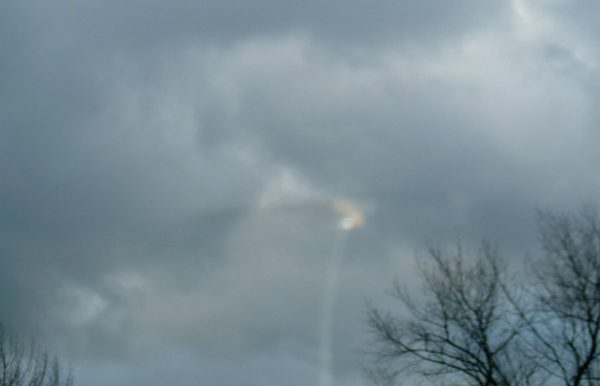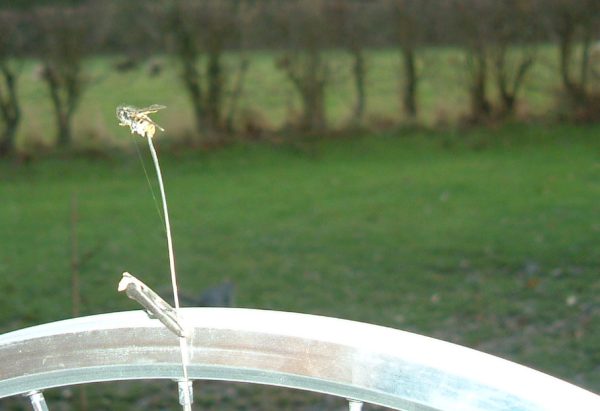The Insect Theory
The 'insect explanation' for the image holds that the streak and flash were caused by an insect flying moderately close to the front of the camera during the exposure. But how could an insect leave such an apparently long streak, and what about the 'flash' at the end?
Taking the streak first, note that the darker it is, the longer a camera shutter has to stay open for in order to collect enough light to get a good picture. The trouble is, if the shutter stays open for a long time, anything that moves appreciably during that time gets blurred along its direction of travel (if you try photographing a car race close up, you have to use shutter speeds of 1/1000th second or higher, and even then you have to track the car during the shot - that gets you a nice sharp car, but it blurs the background, no doubt you've seen the effect).
From background information about the image, we know it was taken with an exposure time of 1/20th second, which is actually quite slow - in fact, at that speed it's pretty hard to get a good handheld photograph because your hands shake a bit (at least, mine do) and then everything comes out blurred (that's one reason people use tripods to support their cameras).
So if we photograph anything moving with an exposure time of 1/20th second, we could reasonably expect it to be blurred along the line of travel. Now 1/20th second might not sound a long time, but even 1 mile per hour is about a foot and a half per second. So an insect flying (or being blown by) at 5mph works out to cover about 4 1/2 inches in 1/20th second - if it was close to the camera, that's several times its body length.
In the case of my test photo, you can make out the 'trail' this caused; judging by eye, I'd say it's about 5 times the length of the body of the wasp that made it. As the wasp was about 1/2 inch long, the streak is about 2 1/2 inches.
So, while the shutter was open, the wasp moved across the field of view, blocking part of the sky in its travel and thus creating the dark streak (the streak can be seen more clearly on the indoor photographs on my 'Experimental Reproduction' page).

But what about the bright blob at the end of the trail? Well, the reason for this is because I had set the camera up to use the flash as well. Now, normally a camera flash is used when it's dark to get around the problems of blurring; it adds a lot of light to the scene so letting you use a much shorter shutter speed (the flash itself lasts around 1/1000th of a second). In the case of the image above, in 1/1000th of a second the wasp would have travelled less than 1/10th of an inch - a small fraction of the body length.
So the picture above is effectively composed of the trail caused by the motion of the wasp during the slow exposure, plus a bright picture of the wasp caused by the short but intense pulse of light from the flash (though the wasp is also blurred because it's too close to the camera, which was meant be focused on the trees in the background; you can tell I'm an amateur!).
Effectively, the camera flash has acted like a single-shot stroboscope. What's interesting is we can tell that the flash actually occurred at the start of the exposure - I was spinning the wheel it was attached to so the wasp was flying head-first - see the picture below, if you imagine the camera being moved down to take a photo of this bug up against the sky background, you can probably relate the body shape to the 'blob' in the picture above.

Finally, I haven't explained why anyone in their right mind would use both slow exposure and flash - or why a supposedly idiot-proof automatic camera (like mine) would even allow such a thing. Well, I noticed my camera has a few different flash modes - red-eye reduction and so on - plus one called 'synchro'. I never knew what that was for, but I do now (thanks to this investigation!). Imagine you're out for a stroll at night with a friend, and they stop and lean against some railings; you think it'd make a great picture, but there's a problem. You want to catch the city lights in the background - so a long exposure is needed. But you want to use flash else your friend is only going to appear as a black silhouette. The answer? 'Synchro' flash! The long exposure captures the city lights perfectly while the flash catchs the smile on your friends face.
And, of course, if a moth happened to flutter through the scene during the exposure, you'd get a trail caused by its motion during the long exposure, with a bright blob at the end where it's frozen by the flash.
Feedback? Send email to hapod<at>hazeii.net